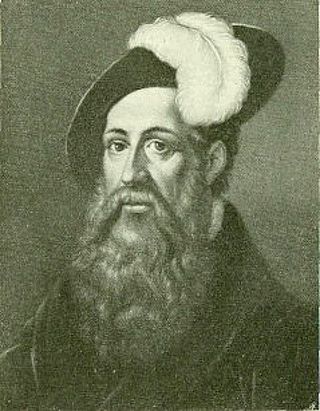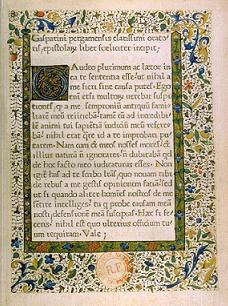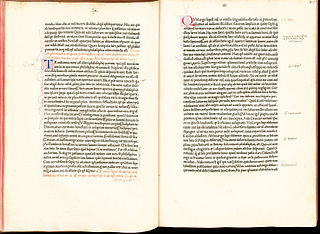
Johannes Gensfleisch zur Laden zum Gutenberg was a German inventor and craftsman who invented the movable-type printing press. Though movable type was already in use in East Asia, Gutenberg's invention of the printing press enabled a much faster rate of printing. The printing press later spread across the world, and led to an information revolution and the unprecedented mass-spread of literature throughout Europe. It had a profound impact on the development of the Renaissance, Reformation, and humanist movements.
This article is a list of the literary events and publications in the 15th century.

Johann Fust or Faust was an early German printer.
The Summa grammaticalis quae vocatur Catholicon, or Catholicon, is a 13th-century Latin dictionary which found wide use throughout Latin Christendom. Some of the entries contain encyclopedic information, and a Latin grammar is also included. The work was created by John Balbi, of Genoa, a Dominican, who finished it on March 7, 1286. The work served in the late Middle Ages to interpret the Bible. The Catholicon was one of the first books to be printed, using the new printing technology of Johannes Gutenberg in 1460.

Peter Schöffer or Petrus Schoeffer was an early German printer, who studied in Paris and worked as a manuscript copyist in 1451 before apprenticing with Johannes Gutenberg and joining Johann Fust, a goldsmith, lawyer, and money lender.

Johann Heynlin, variously spelled Heynlein, Henelyn, Henlin, Hélin, Hemlin, Hegelin, Steinlin; and translated as Jean à Lapide, Jean La Pierre , Johannes Lapideus, Johannes Lapidanus, Johannes de Lapide was a German-born scholar, humanist and theologian, who introduced the first printing press in France (Paris) in 1470.

Arnold Pannartz and Conrad Sweynheym were two printers of the 15th century, associated with Johannes Gutenberg and the use of his invention, the mechanical movable-type printing press.

Johannes Mentelin, sometimes also spelled Mentlin, was a pioneering German book printer and bookseller. In 1466 he printed and published the first German language Bible.

Heinrich Gran was a German book printer of the incunabular era. Together with Johannes Mentelin and Heinrich Eggestein, he was one of the pioneers of book-printing in Alsace.

Hieronymus Vietor was a printer and publisher born in Silesia and active in Vienna and Kraków. Famous for the quality and quantity of his prints, he is considered one of the most important early book printers in Poland, also because he was the first to regularly print in Polish. He is also known as Hieronymus Philovallensis or Hieronymus Doliarius, or in Polish as Hieronim Wietor or Büttner.

Gerhard Dünnhaupt, FRSC is a German bibliographer, literary historian, emeritus professor of the University of Michigan, an honorary life member of the Modern Language Association of America, Elected Fellow and Life Member of the Royal Society of Canada. In September 1983, he chaired the international Martin Luther Quincentennial Conference in Ann Arbor, MI. He is the author of the only annotated bibliography of German Baroque literature.
Adolf Rusch von Ingweiler was a notable German printer and publisher. He was the first printer north of the Alps to print in Antiqua.
Praenumeration was an early form of the subscription business model. It was a common business practice in the 18th century book trade in Germany. The publisher offered to sell a book that was planned but had not yet been printed, usually at a discount, so as to cover their costs in advance. The business practice was particularly common with magazines, helping to determine in advance how many subscribers there would be.
Adam Petri was a printer, publisher and bookseller.
The following is a timeline of the history of the city of Strasbourg, Alsace, France.

The Hortus Sanitatis, a Latin natural history encyclopaedia, was published by Jacob Meydenbach in Mainz, Germany in 1491.

Schwabe Verlag in Basel is the oldest printing and publishing house in the world. The company is based on the Offizin founded by Johannes Petri after 1488 and has since been an independent Swiss family business.
As of 2018, ten firms in Germany rank among the world's biggest publishers of books in terms of revenue: C.H. Beck, Bertelsmann, Cornelsen Verlag, Haufe-Gruppe, Holtzbrinck Publishing Group, Ernst Klett Verlag, Springer Nature, Thieme, WEKA Holding, and Westermann Druck- und Verlagsgruppe. Overall, "Germany has some 2,000 publishing houses, and more than 90,000 titles reach the public each year, a production surpassed only by the United States." Unlike many other countries, "book publishing is not centered in a single city but is concentrated fairly evenly in Berlin, Hamburg, and the regional metropolises of Cologne, Frankfurt, Stuttgart, and Munich."

Martin Schott was a book printer from Strasbourg. One of the earliest printers in Strasbourg, his catalog reflected the tastes of the higher classes in Germany at the time of German humanism.

Peter Schöffer the Younger was a German printer, the son of Peter Schöffer, a former apprentice of Johannes Gutenberg, and a grandson of Gutenberg's financier Johann Fust. He first worked in Mainz, where he set up his first workshop. He was an expert type caster, and his specialty was printing music. Schöffer moved to Worms in 1518, where he printed among other works the Tyndale Bible, which was the first mass-produced English edition of the New Testament, and the first complete German Protestant translation of the Bible. Later in life, he also worked in Straßburg, Venice and Basel.













